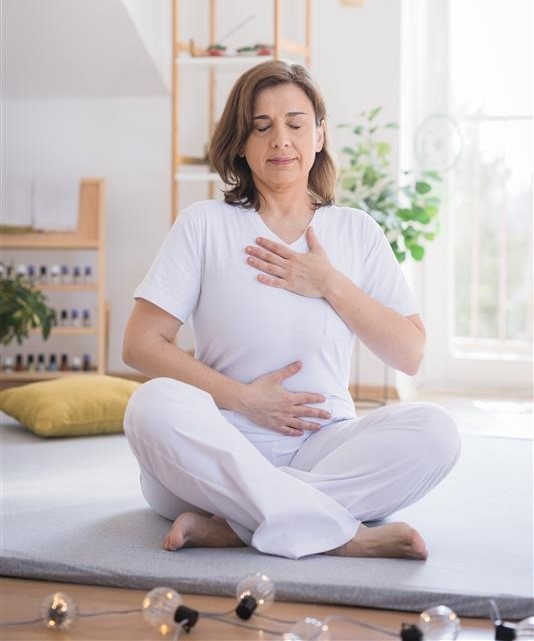The Power of Your Breath
Published
Read time
Do you frequently find yourself feeling stressed during the course of the day?
Perhaps an unexpected email, a difficult discussion with a colleague or feeling nervous before an important event?
We often don’t pay attention to how we breathe; however, during times of stress we may hold our breath unintentionally or take shallow, fast breaths. This in turn activates our sympathetic nervous system, which is our “fight or flight” response, sending a signal to our brain that we are exposed to an external threat. This results in an even more heightened feeling of stress.
Our breath can help us activate our parasympathetic nervous system, which is our “relaxation” response. Slowing our breath and taking full breaths will help us to shift to this state, resulting in feeling calmer. This can be achieved by learning the three-part breath.

Three-part Breath (Dirga Pranayama)
The three-part breath, also known as a “Dirga Pranayama”, is a foundational yogic practice that utilises our full lung capacity, thereby significantly improving oxygen delivery to all the cells in our body. This can have an immediate impact on reducing feelings of stress and anxiety.
The term “Dirga” originates from Sanskrit, meaning “long”. “Pranayama”, is derived from two Sanskrit words: “Prana”, which translates to "vital energy" or "life force, and “Ayama”, which translates to “extension” or “expansion”. Hence the term Pranayama can be translated to “the extension or expansion of vital energy”.
How to Practise the Three-part Breath
1
Find a comfortable position so that your spine is straight and your abdomen in not compressed. You can either lie down on your back on a flat surface or sit up straight on a chair with your feet resting on the ground.
2
Place one hand on your belly and the other hand on your heart. Close your eyes and bring your attention to how you are breathing at rest. Take five to ten normal breaths.
3
Take an Abdominal Breath: Take a deep, slow breath in through your nose and expand your abdomen and observe how your hand moves out. Exhale through your nose, drawing your belly button in towards your spine. Repeat three times.
4
Add Thoracic Breathing: Deepen the breath by taking a slow breath in through your nose and expand your abdomen first, then expand your ribcage so it moves outwards and to the sides. On your breath out, first bring in your ribcage and then draw in your belly button towards your spine. Repeat three times.
5
Complete the Three-Part Breathing: Deepen the breath further. Take a slow, deep breath in through your nose and expand your abdomen, then expand your ribcage and finally feel your upper chest rise. On your breath out, first feel your upper chest fall, then bring in your ribcage and lastly draw in your belly button towards your spine as fully as possible. Repeat three times or more for about two to five minutes.
6
After a few cycles of practising the three-part breath, return to your natural breath for a few cycles before concluding your practice.
Tips for an effective practice
- The three-part breath should feel smooth, continuous and comfortable. If you are finding it difficult, practise with a trained practitioner first.
- Wearing tight clothing may limit full expansion of your abdomen and it is best to ensure you are wearing comfortable clothing during this practice.
- Ensure you breathe in through your nose with your mouth closed. Nasal breathing filters and humidifies the air, and it also releases a substance called nitric oxide which relaxes the airways and blood vessels, improving the delivery of oxygen to our organs.
- You can start with equal inhalations (in breaths) and exhalations (out breaths). For example, if you breathe in for four seconds, also breathe out for four seconds. Once you are comfortable with this, increase your exhalation time so it is 1.5 to 2 times longer compared to your inhalations. For example, if you breathe in for four seconds, breathe out for six to eight seconds.
- Prolonging your exhalations will have additional calming effects as our exhalation is connected to our parasympathetic nervous system or “relaxation response”.
- It is best to practise deep breathing on an empty stomach - either first thing in the morning or three hours after a meal.
- Make your practice consistent. Incorporate three-part breathing daily for five minutes first thing in the morning soon after waking up. This will help you master the technique so that you are more likely to remember to tap into it anytime during the day. Even one to two minutes will help you feel more grounded.
Is deep breathing safe for everyone?
- Individuals that are pregnant or suffer from any medical conditions, take any medications or have been through surgery should check with their healthcare professional prior to starting breathwork.
- If the practice triggers any unexpected symptoms such as dizziness, pain, breathlessness or feelings of anxiety, stop straightaway and return to normal breathing. Speak to your healthcare professional prior to re-starting breathwork.
Any questions?
If you have any questions or comments, please write to us on employeebenefits.mea@howdengroup.com
References
- https://college.acaai.org/better-breathing-guide/
- Lörinczi F, Vanderka M, Lörincziová D, Kushkestani M. Nose vs. mouth breathing- acute effect of different breathing regimens on muscular endurance. BMC Sports Sci Med Rehabil. 2024;16(1):42. Published 2024 Feb 9. doi:10.1186/s13102-024-00840-6
- Russo MA, Santarelli DM, O'Rourke D. The physiological effects of slow breathing in the healthy human. Breathe (Sheff). 2017 Dec;13(4):298-309. doi: 10.1183/20734735.009817. PMID: 29209423; PMCID: PMC5709795.
Disclaimer:
The content in this article is for general informational purpose and is not meant to replace or substitute for professional medical advice, diagnosis or treatment. Always consult a qualified healthcare professional with any questions or concerns about your health.